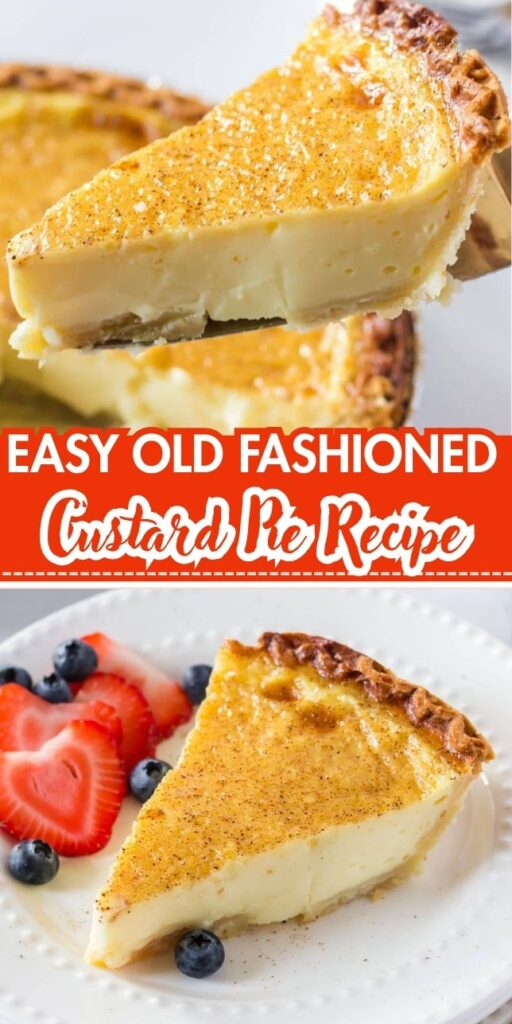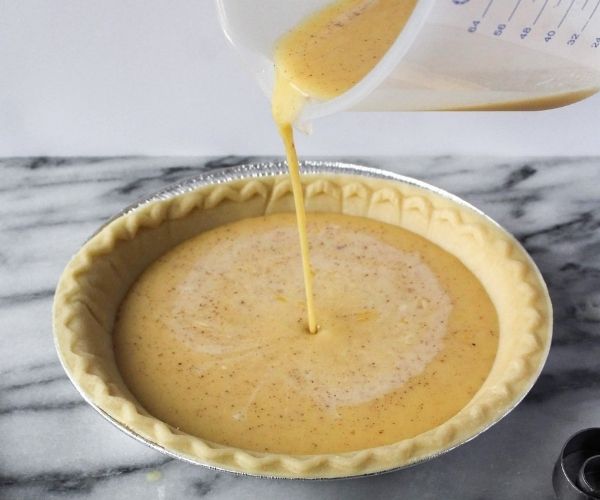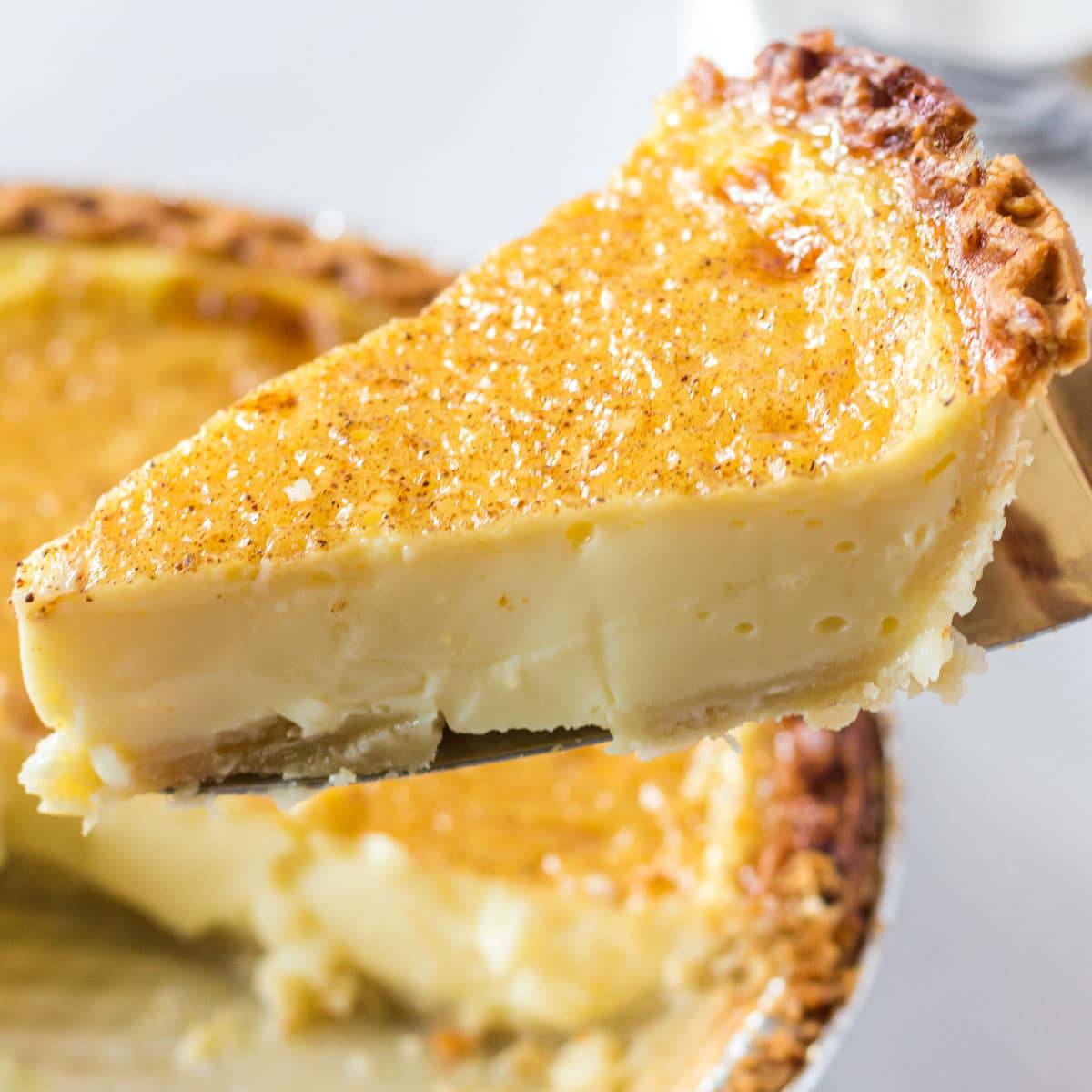
There’s something timeless about the simple elegance of an Old Fashioned Custard Pie. Its golden, silky filling nestled in a buttery, flaky crust is the kind of dessert that evokes memories of cozy kitchens, family gatherings, and the comforting aroma of something baked to perfection.
This pie is a celebration of simplicity — just eggs, milk, sugar, and a touch of vanilla come together to create a luscious custard that wobbles ever so slightly as it cools. If you’re looking for a dessert that feels like a warm hug, you’ve found it.
And here’s a little tip: before you get lost in your own baking adventure, save this pin for recipe — your future self will thank you when it’s time to whip up a nostalgic treat for friends and family.
The magic of this custard pie lies in its texture and flavor. Every bite melts in your mouth, balancing sweet creaminess with a delicate, crisp crust. It’s perfect for holidays, Sunday dinners, or any moment you want to savor something special. With just a handful of pantry staples, you can create a dessert that’s both humble and show-stopping. This pie reminds us that sometimes, the simplest recipes are the most memorable.
Old Fashioned Custard Pie Recipe
Description
It features a simple, flaky pie crust filled with a smooth, creamy custard made from milk, eggs, sugar, and a hint of vanilla. Baked until just set, the custard develops a delicate, velvety texture with a subtle golden top.
This timeless pie is often enjoyed at family gatherings, holiday dinners, or as an everyday sweet treat. Its simplicity allows the natural flavors of the ingredients to shine, making it a nostalgic favorite that evokes warmth and homey charm.
Ingredients
For the Custard Filling:
Instructions
-
Start by making the pie crust, which is the base of this classic dessert. In a large bowl, combine the flour and salt. Add the cold, cubed butter and, using a pastry cutter or your fingertips, cut it into the flour until the mixture resembles coarse crumbs with pea-sized pieces of butter.
-
Gradually add ice water, one tablespoon at a time, mixing until the dough just comes together. Be careful not to overwork it, as you want the crust to remain tender and flaky. Shape the dough into a disk, wrap it in plastic wrap, and refrigerate for at least 30 minutes. This chilling step is essential for a buttery, crisp crust.
-
Once chilled, lightly flour your work surface and rolling pin. Roll the dough into a circle slightly larger than your pie pan (about 12 inches in diameter). Carefully transfer it to a 9-inch pie pan, gently pressing it into the bottom and sides. Trim any excess dough, leaving a small overhang, and crimp the edges for a classic look. Prick the bottom with a fork to prevent bubbling. Optional: Blind bake the crust for 10 minutes at 375°F (190°C) if you prefer a slightly firmer base, but custard pies often bake beautifully without pre-baking.
-
In a medium mixing bowl, whisk together the eggs and sugar until smooth and pale. Add the milk, vanilla extract, nutmeg (if using), and a pinch of salt. Whisk until well combined. The key to a silky custard is gentle mixing—avoid whipping in too much air.
-
Pour the custard mixture into the prepared pie crust. Make sure it’s evenly distributed. Tap the pan gently on the counter to release any air bubbles and ensure a smooth surface.
-
Preheat your oven to 350°F (175°C). Place the pie on the center rack and bake for 40–50 minutes. The custard should be set around the edges but still slightly wobbly in the center, as it will continue to firm up while cooling. Avoid overbaking, which can cause cracking or a grainy texture. If the crust edges brown too quickly, cover them with foil or a pie shield halfway through baking.
-
Once baked, remove the pie from the oven and allow it to cool on a wire rack for at least 2 hours. This resting time lets the custard fully set. Serve the pie slightly chilled or at room temperature, plain or with a dollop of whipped cream. A light sprinkle of nutmeg on top adds a lovely finishing touch.
Nutrition Facts
Servings 8
- Amount Per Serving
- Calories 300kcal
- % Daily Value *
- Total Fat 16g25%
- Saturated Fat 8g40%
- Cholesterol 150mg50%
- Sodium 200mg9%
- Total Carbohydrate 35g12%
- Dietary Fiber 1g4%
- Sugars 22g
- Protein 8g16%
* Percent Daily Values are based on a 2,000 calorie diet. Your daily value may be higher or lower depending on your calorie needs.
Note
Old Fashioned Custard Pie is a timeless dessert, cherished for its smooth, creamy filling and delicate, buttery crust. Unlike modern custard desserts, this classic pie relies on simple ingredients—eggs, milk, sugar, and vanilla—delivering pure comfort with every bite. Its simplicity is what makes it so special, but getting the texture perfectly silky without curdling or cracking requires a few key techniques.
Tips for the Perfect Custard Pie
- Use Fresh Ingredients: Fresh eggs, whole milk or cream, and high-quality vanilla extract make a noticeable difference in flavor. Avoid ultra-processed ingredients to keep the custard smooth and flavorful.
- Pre-Bake the Crust (Blind Baking): To prevent a soggy bottom, pre-bake your pie crust slightly before adding the custard. Line the crust with parchment paper or foil and fill it with pie weights or dried beans. Bake for 10–12 minutes at 375°F (190°C) until lightly golden. Remove weights before pouring in the custard.
- Temper the Eggs: To avoid curdling, slowly add warm milk to the beaten eggs while whisking constantly. This gradual temperature adjustment ensures a silky custard that cooks evenly in the oven.
- Strain the Custard: Pouring the mixture through a fine-mesh sieve before baking removes any stray egg strands, resulting in a perfectly smooth texture.
- Bake in a Water Bath: Place the filled pie pan in a larger baking dish filled with hot water (about halfway up the sides of the pie). This gentle, even heat prevents cracking and keeps the custard creamy.
- Do Not Overbake: Custard continues to cook after leaving the oven. Look for a slight jiggle in the center when gently shaken—it should not be liquid but will firm up as it cools. Overbaking causes cracks and a rubbery texture.
- Cool Slowly: Allow the pie to cool at room temperature for about 30–60 minutes before refrigerating. Rapid temperature changes can cause the custard to shrink or crack. Refrigerate for at least 2–3 hours before serving for the best texture.
Serving Tricks and Presentation Ideas
- Classic Dusting: Sprinkle a light layer of cinnamon or nutmeg on top for a warm, inviting aroma and a touch of elegance.
- Whipped Cream Topping: Add freshly whipped cream, either piped decoratively or dolloped generously on each slice. For extra flavor, fold in a bit of vanilla or cinnamon.
- Fruit Pairing: Fresh berries, sliced peaches, or a drizzle of berry compote complements the custard’s richness with a pop of color and tartness.
- Individual Servings: Bake the custard in ramekins for personal servings. This reduces cutting difficulties and makes a charming presentation for guests.
- Serve Slightly Chilled: While some enjoy it at room temperature, serving slightly chilled enhances the custard’s creamy consistency and balances its sweetness.
Extra Tricks:
- For added flavor depth, infuse the milk with a split vanilla bean or a cinnamon stick, removing before mixing with eggs.
- For a golden top, lightly brush the surface with cream before baking.
- If cracks appear, don’t worry—dusting powdered sugar or adding a decorative topping can disguise them.
Servings: A standard 9-inch custard pie serves 6–8 people, making it perfect for family dinners, holiday tables, or weekend desserts. It pairs beautifully with tea or coffee for an afternoon treat.
Tips for the Perfect Old Fashioned Custard Pie
- Use fresh ingredients: Fresh eggs and whole milk make a noticeable difference in flavor and texture.
- Avoid overmixing: Whipping too much air into the custard can lead to cracks and a less smooth texture.
- Check for doneness carefully: The center should jiggle slightly, not be liquid. It will firm up as it cools.
- Experiment with flavors: Add a tablespoon of bourbon or a teaspoon of almond extract for a unique twist while keeping the traditional vibe.
Serving Suggestions
Old Fashioned Custard Pie is versatile and pairs beautifully with simple accompaniments:
- Fresh berries or a fruit compote
- Whipped cream or crème fraîche
- A light dusting of cinnamon or nutmeg
This pie is also ideal for potlucks, afternoon tea, or as a comforting dessert after a family meal. Its classic flavor appeals to all ages, making it a crowd-pleaser every time.
Conclution:
In conclusion, Old Fashioned Custard Pie is a dessert that celebrates simplicity and technique. With the right tips and tricks, you can achieve a perfectly smooth, creamy custard with a tender crust every time.
Attention to details like temperature control, gentle baking, and careful cooling ensures your pie will impress both in flavor and presentation.
Serving it with fresh cream, fruits, or a sprinkle of spice elevates this classic dessert into a timeless centerpiece for any occasion.
Frequently Asked Questions
What is Old Fashioned Custard Pie?
Old Fashioned Custard Pie is a classic dessert made with a simple mixture of eggs, milk or cream, sugar, and a hint of vanilla, baked in a pie crust until set.
Its smooth, creamy texture and subtle sweetness make it a timeless favorite, often served at family gatherings or holiday meals. Unlike pumpkin or sweet potato pies, it relies entirely on the custard filling for flavor, showcasing the elegance of simplicity.
How do I make the custard without it curdling?
To prevent curdling, it’s important to whisk eggs gently and avoid overmixing. Use room-temperature ingredients, and bake the pie in a moderate oven (around 350°F/175°C). Many recipes recommend a water bath (placing the pie pan inside a larger pan with hot water) to ensure even baking and prevent cracking. Keep an eye on the pie; it’s done when the center is slightly jiggly but not liquid.
Can I make Old Fashioned Custard Pie ahead of time?
Yes! Custard pie actually benefits from chilling. After baking, let the pie cool to room temperature, then refrigerate for at least 2–3 hours or overnight. This helps the custard firm up and enhances the flavor. Cover loosely with plastic wrap to avoid absorbing fridge odors. Serve chilled or at room temperature.
What variations can I try?
While traditional custard pie is simple, you can experiment by adding nutmeg, cinnamon, or lemon zest for extra flavor. Some people like a splash of bourbon or vanilla bean for a richer taste. You can also use a pre-baked pie crust or make a graham cracker crust for a slightly different texture and flavor.








